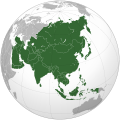The term "New World" is still commonly employed when discussing historic spaces, particularly the voyages of Christopher Columbus and the subsequent European colonization of the Americas. It has been framed as being problematic for applying a colonial perspective of discovery and not doing justice to either the historic or geographic complexity of the world. It is argued that both 'worlds' and the age of Western colonialism rather entered a new stage, [29] as in the 'modern world'.
Particular usage
In wine terminology, "New World" uses a particular definition. "New World wines" include not only North American and South American wines, but also those from South Africa, Australia, New Zealand, and all other locations outside the traditional wine-growing regions of Europe, North Africa and the Near East. [30] The usefulness of these terms for wines though have been questioned as arbitrary and too generalized. [31]
In a biological context, species can be divided into those in the Old World (Palearctic, Afrotropic) and those in the New World (Nearctic, Neotropic). Biological taxonomists often attach the "New World" label to groups of species found exclusively in the Americas, to distinguish them from their counterparts in the "Old World" (Europe, Africa and Asia)—e.g., New World monkeys, New World vultures, New World warblers.
The label is also often used in agriculture. Asia, Africa, and Europe share a common agricultural history stemming from the Neolithic Revolution, and the same domesticated plants and animals spread through these three continents thousands of years ago, making them largely indistinct and useful to classify together as "Old World". Common Old World crops, e.g., barley, lentils, oats, peas, rye, wheat, and domesticated animals, e.g., cattle, chickens, goats, horses, pigs, sheep, did not exist in the Americas until they were introduced by post-Columbian contact in the 1490s.
Many common crops were originally domesticated in the Americas before they spread worldwide after Columbian contact, and are still often referred to as "New World crops". Common beans (phaseolus), maize, and squash—the "three sisters"—as well as the avocado, tomato, and wide varieties of capsicum (bell pepper, chili pepper, etc.), and the turkey were originally domesticated by pre-Columbian peoples in Mesoamerica. Agriculturalists in the Andean region of South America brought forth the cassava, peanut, potato, quinoa and domesticated animals like the alpaca, guinea pig and llama.
Other New World crops include the sweetpotato, cashew, cocoa, rubber, sunflower, tobacco, and vanilla, and fruits like the guava, papaya and pineapple. There are rare instances of overlap, e.g., the calabash (bottle-gourd), cotton, and yam are believed to have been domesticated separately in both the Old and New World, or their early forms possibly brought along by Paleo-Indians from Asia during the last glacial period.















